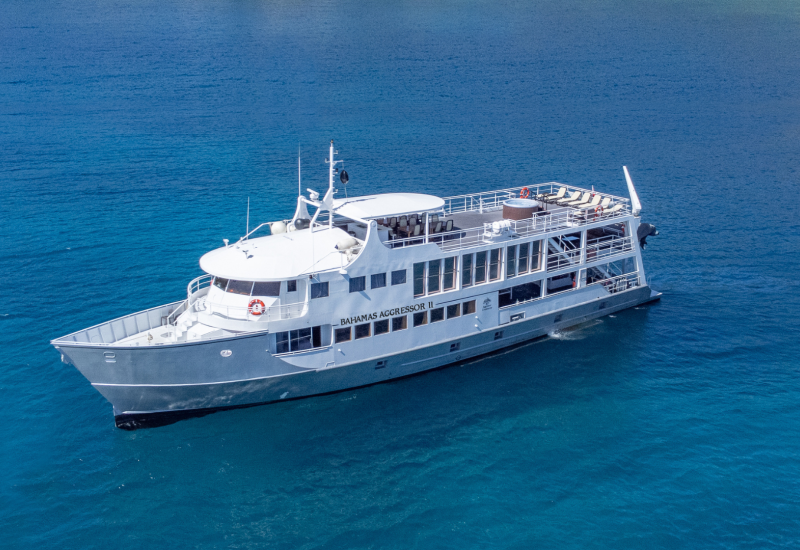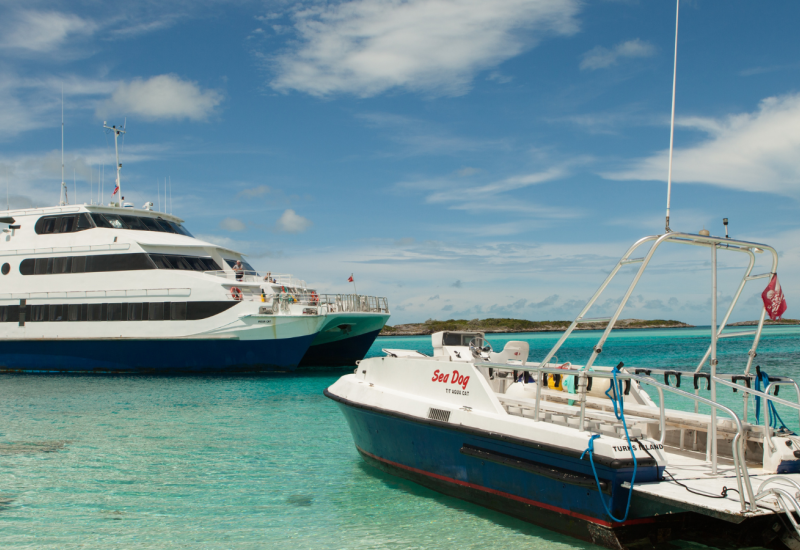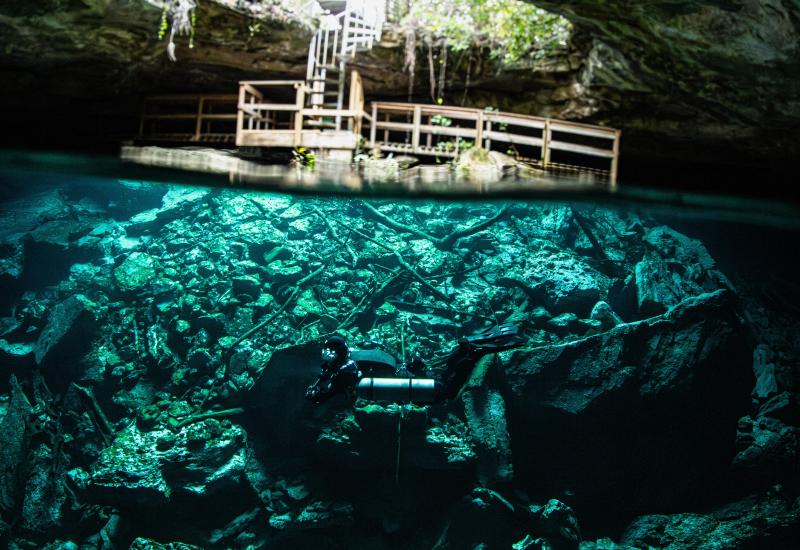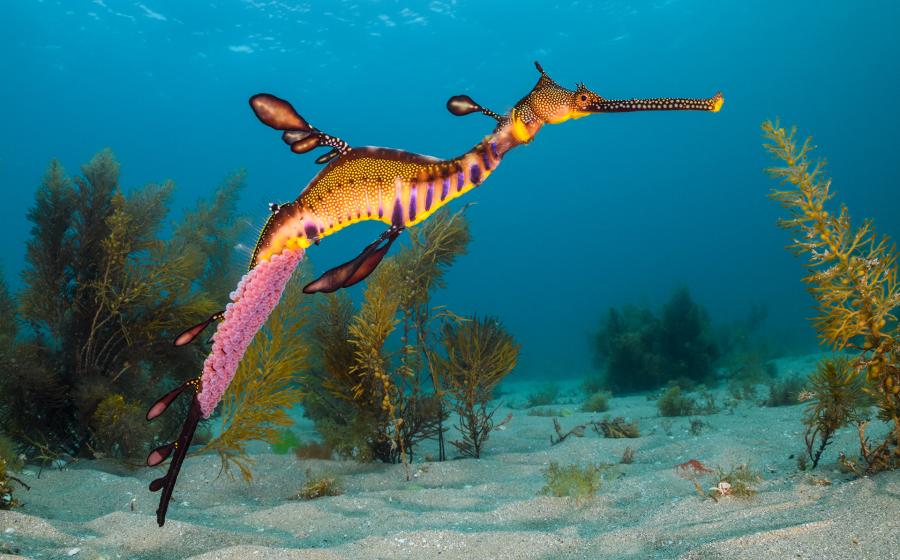Diving Into an Inland Blue Hole Cave System

Dive Log: The Guardian
This serene inland blue hole serves as the portal to a mysterious and beautiful subterranean cave system.
Patricia Wuest
We arrived at the Guardian after a 45-minute drive down the bumpy dirt roads of Andros Island. As we pulled up, there was nothing but mangroves and a few small puddles left over from the prior day's storms. The thick mangroves prevented us from seeing anything that resembled a blue hole, but was reminiscent of the back areas of Bonaire. We geared up in the back of the truck and threw our gear over our shoulders. We followed a path of probably half a mile through mud, roots and more puddles.
The Pond
We finally turned a corner and there in front of us was a good-size golden-brown pond about the size of your average city-owned swimming pool. It was late in the afternoon, and the water was glistening under the lowering sun. Given the heat and the sweat on our brow,s the water couldn't have been more inviting. One by one, we strode into the water and did a final gear check on the surface to ensure all primary and redundant systems were working and in place.
The Descent
Our dive leader from Small Hope Bay Lodge, Joe, had prepped us on the dive and was now calling for us to make our initial descent into the murky water. As I descended, the 15-foot vis was reminiscent of that of my usual diving grounds of New England. The only difference: It was a balmy 82 degrees. We continued our drop and approached the mouth of the cave system that had been named “The Guardian.” We made contact with the guide line and made our way inside. The walls were covered with white bacteria that was sort of glowing in the yellowy-gold water. We started descending down what felt like an elevator shaft. It was just as narrow and seemed to be a very steep decline. I checked my gauge and we had reached 60 feet already. It was hard to see those in front and behind, even with the canister lights that we had been equipped with.
Hitting the Salt-Water Halocline
Suddenly, out of nowhere, the vis went from 10 feet to 100-feet-plus! We had crossed over from the fresh water to the salt water that Joe had briefed us on. I checked my gauges and we had hit a depth of around 90 feet. The rest off this elevator shaft was now totally in view and you could see for as far as your light would reach. As we continued our path down, the eyes were teased with magnificent stalagmites and stalactites. The walls of the cave were a dark brown with a few hints of red here and there. The decline began to end and we flattened out at our max depth of 154 feet. We moved forward and the tunnel opened up into a large cathedral-like room. I couldn't tell if it was the effects of narcosis or the sheer awesomeness that was presented in front of me but I was awestruck and felt an overwhelming sense of exploration. This is what the serious cavers must get hooked on, and I can see why.
Heading Up and Out
The turnaround point came and we flipped ourselves round and headed back. As we were making our way up the elevator shaft, the surrounding water looked like it was snowing. Our exhaust bubbles had dislodged the bacteria that rested on the roof on the way down and now it was gently floating toward the bottom of the dark abyss that lay beneath us. The water went from clear to gold again; the sulfur in the water formed rings that looked like those that surround Saturn. We ascended through them, back toward the entrance. I looked up and could see the end of day sun glowing through the water lighting up the entranceway with a magnificent amber color. The closest thing I can describe it as is a stained-glass window from a cathedral, which I felt was somewhat funny since the depths of this dive were as awe-inspiring as walking into some of the most tremendous architecture ever built by man.
We finished our stop and made our way up. As I breached the surface and saw my new friend Patricia Wuest, Scuba Diving's senior editor. She asked me how the dive went. I believe all I could muster at the time was a solitary “AWESOME!”
Editor's Note: Nick said something slightly different than "awesome," but suffice it to say, bring your diving cred and moxie to make this dive. Small Hope Bay Lodge (smallhope.com) can put you in the water here and at other inland blue holes.
Nick Fazah is an Instructor Trainer/Manager at East Coast Divers, Brookline, MA.
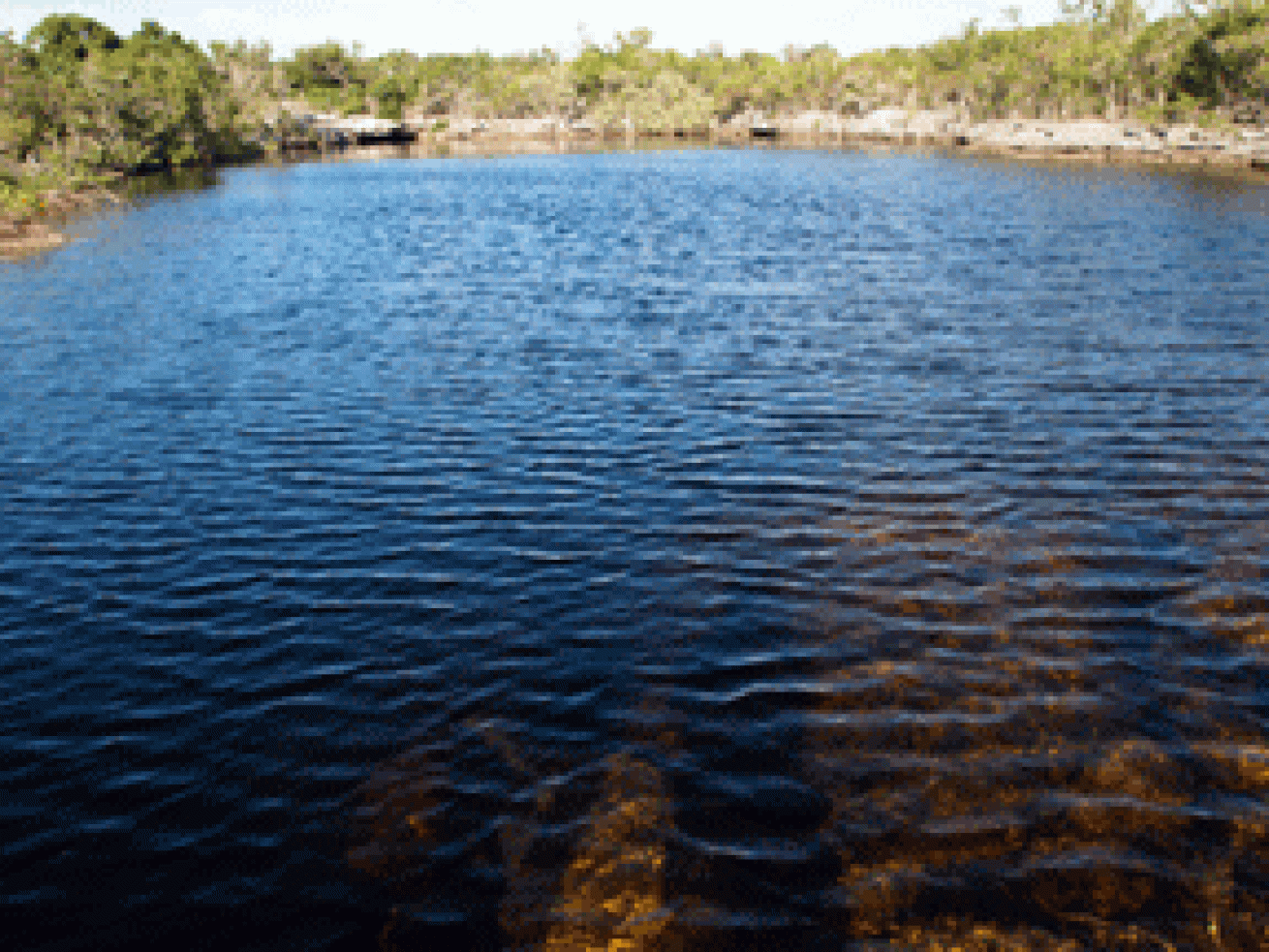
Patricia WuestThis serene inland blue hole serves as the portal to a mysterious and beautiful subterranean cave system.
We arrived at the Guardian after a 45-minute drive down the bumpy dirt roads of Andros Island. As we pulled up, there was nothing but mangroves and a few small puddles left over from the prior day's storms. The thick mangroves prevented us from seeing anything that resembled a blue hole, but was reminiscent of the back areas of Bonaire. We geared up in the back of the truck and threw our gear over our shoulders. We followed a path of probably half a mile through mud, roots and more puddles.
The Pond
We finally turned a corner and there in front of us was a good-size golden-brown pond about the size of your average city-owned swimming pool. It was late in the afternoon, and the water was glistening under the lowering sun. Given the heat and the sweat on our brow,s the water couldn't have been more inviting. One by one, we strode into the water and did a final gear check on the surface to ensure all primary and redundant systems were working and in place.
The Descent
Our dive leader from Small Hope Bay Lodge, Joe, had prepped us on the dive and was now calling for us to make our initial descent into the murky water. As I descended, the 15-foot vis was reminiscent of that of my usual diving grounds of New England. The only difference: It was a balmy 82 degrees. We continued our drop and approached the mouth of the cave system that had been named “The Guardian.” We made contact with the guide line and made our way inside. The walls were covered with white bacteria that was sort of glowing in the yellowy-gold water. We started descending down what felt like an elevator shaft. It was just as narrow and seemed to be a very steep decline. I checked my gauge and we had reached 60 feet already. It was hard to see those in front and behind, even with the canister lights that we had been equipped with.
Hitting the Salt-Water Halocline
Suddenly, out of nowhere, the vis went from 10 feet to 100-feet-plus! We had crossed over from the fresh water to the salt water that Joe had briefed us on. I checked my gauges and we had hit a depth of around 90 feet. The rest off this elevator shaft was now totally in view and you could see for as far as your light would reach. As we continued our path down, the eyes were teased with magnificent stalagmites and stalactites. The walls of the cave were a dark brown with a few hints of red here and there. The decline began to end and we flattened out at our max depth of 154 feet. We moved forward and the tunnel opened up into a large cathedral-like room. I couldn't tell if it was the effects of narcosis or the sheer awesomeness that was presented in front of me but I was awestruck and felt an overwhelming sense of exploration. This is what the serious cavers must get hooked on, and I can see why.
Heading Up and Out
The turnaround point came and we flipped ourselves round and headed back. As we were making our way up the elevator shaft, the surrounding water looked like it was snowing. Our exhaust bubbles had dislodged the bacteria that rested on the roof on the way down and now it was gently floating toward the bottom of the dark abyss that lay beneath us. The water went from clear to gold again; the sulfur in the water formed rings that looked like those that surround Saturn. We ascended through them, back toward the entrance. I looked up and could see the end of day sun glowing through the water lighting up the entranceway with a magnificent amber color. The closest thing I can describe it as is a stained-glass window from a cathedral, which I felt was somewhat funny since the depths of this dive were as awe-inspiring as walking into some of the most tremendous architecture ever built by man.
We finished our stop and made our way up. As I breached the surface and saw my new friend Patricia Wuest, Scuba Diving's senior editor. She asked me how the dive went. I believe all I could muster at the time was a solitary “AWESOME!”
Editor's Note: Nick said something slightly different than "awesome," but suffice it to say, bring your diving cred and moxie to make this dive. Small Hope Bay Lodge (smallhope.com) can put you in the water here and at other inland blue holes.
Nick Fazah is an Instructor Trainer/Manager at East Coast Divers, Brookline, MA.

